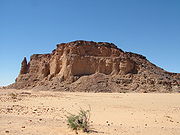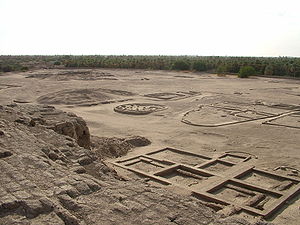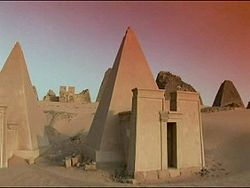
Nubian architecture
Encyclopedia

Nubia
Nubia is a region along the Nile river, which is located in northern Sudan and southern Egypt.There were a number of small Nubian kingdoms throughout the Middle Ages, the last of which collapsed in 1504, when Nubia became divided between Egypt and the Sennar sultanate resulting in the Arabization...
which date from 6000 BC. These villages were roughly contemporary with the walled town of Jericho
Jericho
Jericho ; is a city located near the Jordan River in the West Bank of the Palestinian territories. It is the capital of the Jericho Governorate and has a population of more than 20,000. Situated well below sea level on an east-west route north of the Dead Sea, Jericho is the lowest permanently...
in Palestine
Palestine
Palestine is a conventional name, among others, used to describe the geographic region between the Mediterranean Sea and the Jordan River, and various adjoining lands....
.
Early Period

A-group
A-Group is the designation for a distinct culture that arose between the First and Second Cataracts of the Nile in Nubia betweenthe Egyptian 1st dynasty and the 3rd millennium BC.The A-Group settled on very poor land with scarce natural resources, yet...
(c. 3500-2374 BCE) culture, as seen in the Sofala Cave rock cut temple. Egyptians made widespread use of speos during the New Kingdom. Two types of A-Group graves exist. One was oval in shape .8m deep. The second was oval in shape 1.3m deep with a deeper second chamber.
A-Group
A-group
A-Group is the designation for a distinct culture that arose between the First and Second Cataracts of the Nile in Nubia betweenthe Egyptian 1st dynasty and the 3rd millennium BC.The A-Group settled on very poor land with scarce natural resources, yet...
culture vanished leading to C-Group
C-Group
The C-Group was a culture in ancient Nubia. It was named by George A. Reisner. With no central site, and no written evidence about what these people called themselves, Reisner assigned it a letter...
culture(2200- 1500 BCE). C-Group
C-Group
The C-Group was a culture in ancient Nubia. It was named by George A. Reisner. With no central site, and no written evidence about what these people called themselves, Reisner assigned it a letter...
culture appeared around c. 2200 BC. Settlement consisted of round structures with stone floors. Structural frame was achieved with wooden or pliant materials. Mud-bricks became the preferred building materials as settlements became larger. Graves were circular cylindrical superstructures made of stoned wall. The pit was filled with gravel and stones, and covered with dried mud roof or hay roof. Later, during the Second Intermediate Period, a mud-brick chapel was placed to the north of the grave. Graves were from El Ghaba, Kadero, Sayala, and various other sites in northern Sudan.
Kerma

C-Group
The C-Group was a culture in ancient Nubia. It was named by George A. Reisner. With no central site, and no written evidence about what these people called themselves, Reisner assigned it a letter...
culture was related to Kerma
Kerma
Kerma was the capital city of the Kingdom of Kerma, which was located in present day Egypt and Sudan. The Kerma site has been confirmed by archaeology to be at least 9,500 years old. Around 3000 BC, a cultural tradition began around Kerma...
-Culture. Kerma
Kerma
Kerma was the capital city of the Kingdom of Kerma, which was located in present day Egypt and Sudan. The Kerma site has been confirmed by archaeology to be at least 9,500 years old. Around 3000 BC, a cultural tradition began around Kerma...
was settled around 2400 BC.It was a walled city containing religious building, large circular dwelling, a palace, and well laid out roads. On the East side of the city, funerary temple and chapel were laid out. It supported a population of 2,000. One of its most endearing structure was the Deffufa, a mud brick temple which ceremonies were performed on top.
The deffufa is a unique structure in Nubian Architecture. Three known deffufa exist. The Western Deffufa at Kerma
Kerma
Kerma was the capital city of the Kingdom of Kerma, which was located in present day Egypt and Sudan. The Kerma site has been confirmed by archaeology to be at least 9,500 years old. Around 3000 BC, a cultural tradition began around Kerma...
, an Eastern Deffufa, and a third little known deffufa. The Western Deffufa is 50m by 25m. It is 18 meters tall and comprises three stories.
It was surrounded by a boundary wall. Inside were chambers connected by passageways.
The Eastern Deffufa lies 2 km east of the Western Deffufa. The Eastern Deffufa is shorter than the Western Deffufa, just two stories high. It is considered a funerary chapel, being surrounded by 30,000 tumuli or graves. It has two columned halls. The walls are decorated with portraiture of animal in color schemes of red, blue, yellow, and black and stone laid floors. Exterior walls were layered with stone. The third deffufa is of similar structure as the Eastern Deffufa.
The Kerma
Kerma
Kerma was the capital city of the Kingdom of Kerma, which was located in present day Egypt and Sudan. The Kerma site has been confirmed by archaeology to be at least 9,500 years old. Around 3000 BC, a cultural tradition began around Kerma...
graves are distinct. They are circular pits covered with white or black pebbles in a circular mound. Four huge graves in the southern part of the site exist. They lie in rows surrounded by smaller graves. The diameter is 300 ft(9 m) covered with circular mounds of white and black dessert pebbles, 3 m high. Underneath exist a complex structure. A pathway running along the diameter is laid with mud walls, supporting the above mound. The mud walls seemed to have been once decorated. The pathway goes to a vaulted
Nubian vault
In architecture, a Nubian vault is a type of curved surface forming a vaulted structure. The mudbrick structure was revived by Egyptian architect Hassan Fathy after re-discovering the technique in the Nubian village of Abu al-Riche. The technology is advocated by environmentalists as...
chamber with a wooden door, where the king is buried. The king's bed is elaborate with stone carved legs. The vaulted
Nubian vault
In architecture, a Nubian vault is a type of curved surface forming a vaulted structure. The mudbrick structure was revived by Egyptian architect Hassan Fathy after re-discovering the technique in the Nubian village of Abu al-Riche. The technology is advocated by environmentalists as...
chamber lies in the center of the structure. It is estimated 300 humans and 1000 cattle were probably sacrificed with the king to accompany him in the after-life.
Kush and Napata

Kingdom of Kush
The native name of the Kingdom was likely kaš, recorded in Egyptian as .The name Kash is probably connected to Cush in the Hebrew Bible , son of Ham ....
. Kush
Kingdom of Kush
The native name of the Kingdom was likely kaš, recorded in Egyptian as .The name Kash is probably connected to Cush in the Hebrew Bible , son of Ham ....
was immensely influenced by Egypt
Ancient Egypt
Ancient Egypt was an ancient civilization of Northeastern Africa, concentrated along the lower reaches of the Nile River in what is now the modern country of Egypt. Egyptian civilization coalesced around 3150 BC with the political unification of Upper and Lower Egypt under the first pharaoh...
and eventually conquered Egypt
Ancient Egypt
Ancient Egypt was an ancient civilization of Northeastern Africa, concentrated along the lower reaches of the Nile River in what is now the modern country of Egypt. Egyptian civilization coalesced around 3150 BC with the political unification of Upper and Lower Egypt under the first pharaoh...
. During this phase we see the building of numerous pyramids and temples.
Of much spiritual significance to Nubian pharaohs was Gebel Barkal. Nubian pharaohs received legitimacy from the site. They held pharaonic coronation and consulted its oracle. It was thought to be the dwelling place of Amen-Ra. Temples for Mut, Hathor, and Bes are found. Thirteen temples and three palaces have been excavated. The city of Napata has not been fully excavated. Some of the temples were started by various pharaohs and were added on by succeeding pharaohs, beginning with Egyptian pharaohs. Reisner excavated the region, labeling its monuments B for Barkal. Some are as follows: B200(temple of Taharqa
Taharqa
Taharqa was a pharaoh of the Ancient Egyptian 25th dynasty and king of the Kingdom of Kush, which was located in Northern Sudan.Taharqa was the son of Piye, the Nubian king of Napata who had first conquered Egypt. Taharqa was also the cousin and successor of Shebitku. The successful campaigns of...
), B300(Taharqa
Taharqa
Taharqa was a pharaoh of the Ancient Egyptian 25th dynasty and king of the Kingdom of Kush, which was located in Northern Sudan.Taharqa was the son of Piye, the Nubian king of Napata who had first conquered Egypt. Taharqa was also the cousin and successor of Shebitku. The successful campaigns of...
's temple of Mut
Mut
Mut, which meant mother in the ancient Egyptian language, was an ancient Egyptian mother goddess with multiple aspects that changed over the thousands of years of the culture. Alternative spellings are Maut and Mout. She was considered a primal deity, associated with the waters from which...
, Hathor
Hathor
Hathor , is an Ancient Egyptian goddess who personified the principles of love, beauty, music, motherhood and joy. She was one of the most important and popular deities throughout the history of Ancient Egypt...
, Bes
Bes
Bes was an Egyptian deity worshipped in the later periods of dynastic history as a protector of households and in particular mothers and children. In time he would be regarded as the defender of everything good and the enemy of all that is bad...
), B500(temple), B501(outer court), B502(hypostle hall), B700(temple), B800sub(temple of Alara
Alara
Alara may refer to:* Alara , a popular Turkish name* Alara , an insect genus in the family Derbidae* ALARA, an acronym for "As Low As Reasonably Achievable"* Alara of Nubia, the unifier of Kush...
), B1200(palace). Psamtik II of the 26th Dynasty of Egypt
Twenty-sixth dynasty of Egypt
The Twenty-sixth Dynasty of Egypt was the last native dynasty to rule Egypt before the Persian conquest in 525 BC . The Dynasty's reign The Twenty-sixth Dynasty of Egypt (also written Dynasty XXVI or Dynasty 26) was the last native dynasty to rule Egypt before the Persian conquest in 525 BC...
sacked the region in 593 BC, destroying all Nubian statues in B500.
Nubian Pyramids were constructed on three major sites El Kurru, Nuri, and Meroe. More pyramids were constructed and for the longest time in Nubia than in Egypt. Nubia contains 223 pyramids.
They were smaller than Egyptian pyramids. Nubian pyramids were for Kings and Queens. The general construction of Nubian pyramids consisted of steep walls, a chapel facing East, stairway facing East, and a chamber access via the stairway.
El Kurru was the first major site, 13 km South from Gebel Barkal. It was made of sandstone. It range from 10 m to 30 m in height. About 10 pharaohs and 14 queens were buried at El Kurru.
Nuri
Nuri
Nuri is a place in modern Sudan on the south side of the Nile. Close to it, there are pyramids belonging to Nubian kings. Nuri is situated about 15 km north of Sanam, and 10 km from Jebel Barkal. All these remains belonged to the ancient city Napata, the first capital of the Nubian kingdom of...
was another important pyramid site, 6 miles Northeast of Gebel Barkal. It housed 20 pharaohs and 54 queens. The pharaoh's pyramids range from 39.5 m to 65 m in height. The queen pyramid 9 m to 17 m. The tombs were cut out of bedrock. The pharaoh's chamber contained three interconnecting chambers. The queen's contained two interconnecting chambers.
Meroë

Nubian pyramids
Nubian pyramids are pyramids that were built by the rulers of the Kushite and Egyptian kingdoms. Prior to the Kushites building these pyramids , there had been no pyramid construction in Egypt and the Nile Valley for more than 500 years.The area of the Nile valley known as Nubia, which lies within...
site Meroë
Meroë
Meroë Meroitic: Medewi or Bedewi; Arabic: and Meruwi) is an ancient city on the east bank of the Nile about 6 km north-east of the Kabushiya station near Shendi, Sudan, approximately 200 km north-east of Khartoum. Near the site are a group of villages called Bagrawiyah...
is considered to be the largest archaeological site in the world. It contains more Nubian Pyramids than any other site.
The ancient Nubians
Nubia
Nubia is a region along the Nile river, which is located in northern Sudan and southern Egypt.There were a number of small Nubian kingdoms throughout the Middle Ages, the last of which collapsed in 1504, when Nubia became divided between Egypt and the Sennar sultanate resulting in the Arabization...
established a system of geometry including early versions of sun clocks. Many are located at the sites of Meroë. During the Meroitic period in Nubian history the ancient Nubians
Nubia
Nubia is a region along the Nile river, which is located in northern Sudan and southern Egypt.There were a number of small Nubian kingdoms throughout the Middle Ages, the last of which collapsed in 1504, when Nubia became divided between Egypt and the Sennar sultanate resulting in the Arabization...
used a trigonometric methodology similar to the Egyptians.
Christian Nubia

Nubia
Nubia is a region along the Nile river, which is located in northern Sudan and southern Egypt.There were a number of small Nubian kingdoms throughout the Middle Ages, the last of which collapsed in 1504, when Nubia became divided between Egypt and the Sennar sultanate resulting in the Arabization...
began in the 6th century AD. Its most representative architecture are churches. They are based on Byzantium
Byzantium
Byzantium was an ancient Greek city, founded by Greek colonists from Megara in 667 BC and named after their king Byzas . The name Byzantium is a Latinization of the original name Byzantion...
Basilicas. The structures are relatively small and made of mud bricks. The church is rectangular in shape with North and South isles. Columns are used to divide the nave. On the East side is the apse. The altar stood in front of the apse. The area between the altar and apse was called the Haikal. At the West, was a tower or upper room also in the South corner and North corner. Doors were in the North and South walls. A few church survived which were more elaborate, were built of stone, two in Faras and the Ghazail Church.
Church painting with biblical themes were extensive but few survived. The best surviving church painting were on the Rivergate Church of Faras and the Church of Ab El Qadir.
Vernacular architecture of the Christian period is scarce. Architecture of Soba is the only one that has been excavated . The structures are of sun dried bricks, same as present day Sudan, except for an arch.
One prominent feature of Nubian churches are vaults
Nubian vault
In architecture, a Nubian vault is a type of curved surface forming a vaulted structure. The mudbrick structure was revived by Egyptian architect Hassan Fathy after re-discovering the technique in the Nubian village of Abu al-Riche. The technology is advocated by environmentalists as...
(dome) made out of mud-bricks. The mud-brick structure was revived by Egyptian architect Hassan Fathy
Hassan Fathy
Hassan Fathy was a noted Egyptian architect who pioneered appropriate technology for building in Egypt, especially by working to re-establish the use of mud brick and traditional as opposed to western building designs and lay-outs...
after rediscovering the technique in the Nubian village of Abu al-Riche . The technology is advocated by environmentalist as environmentally friendly and sustainable, since it makes use of pure earth without the need of timber.
Islamic Nubia
The conversion to Islam was a slow, gradual process, with almost 600 hundred years of resistance. Most of the architecture of the period are mosques built of mud-bricks. One of the first attempt at conquest was by Egyptian-Nubian, Ibn Abi Sarh. Ibn Abi Sarh was a Muslim leader who tried to conquer all Nubia in the 8th century AD. It was almost a complete failure. An agreement called the Baqt, shaped Egyptian-Nubian relations for six centuries, and permitted the construction of a mosque in the Nubian capital of Dongola for Muslim travelers. By the middle of the 14th century, NubiaNubia
Nubia is a region along the Nile river, which is located in northern Sudan and southern Egypt.There were a number of small Nubian kingdoms throughout the Middle Ages, the last of which collapsed in 1504, when Nubia became divided between Egypt and the Sennar sultanate resulting in the Arabization...
had been converted to Islam. The royal Church of Dongola was converted into a mosque. Numerous other churches were converted to mosque.
Graves were simple pits, with bodies pointing to Mecca. Some of the unique structures were the gubbas, graves reserved for Muslim saints. They were whitewashed domes made of adobe bricks.

